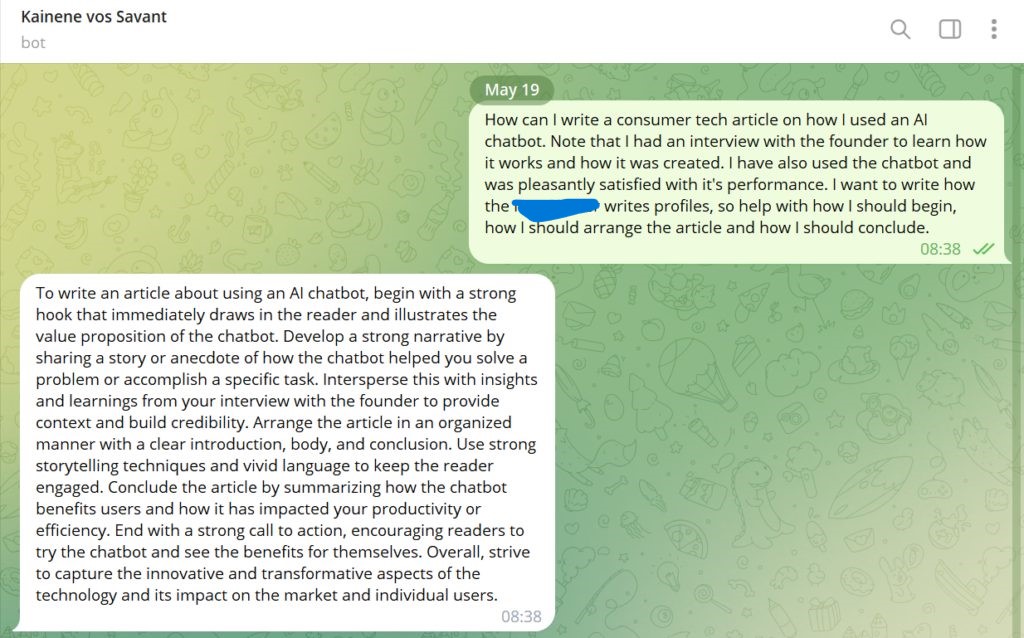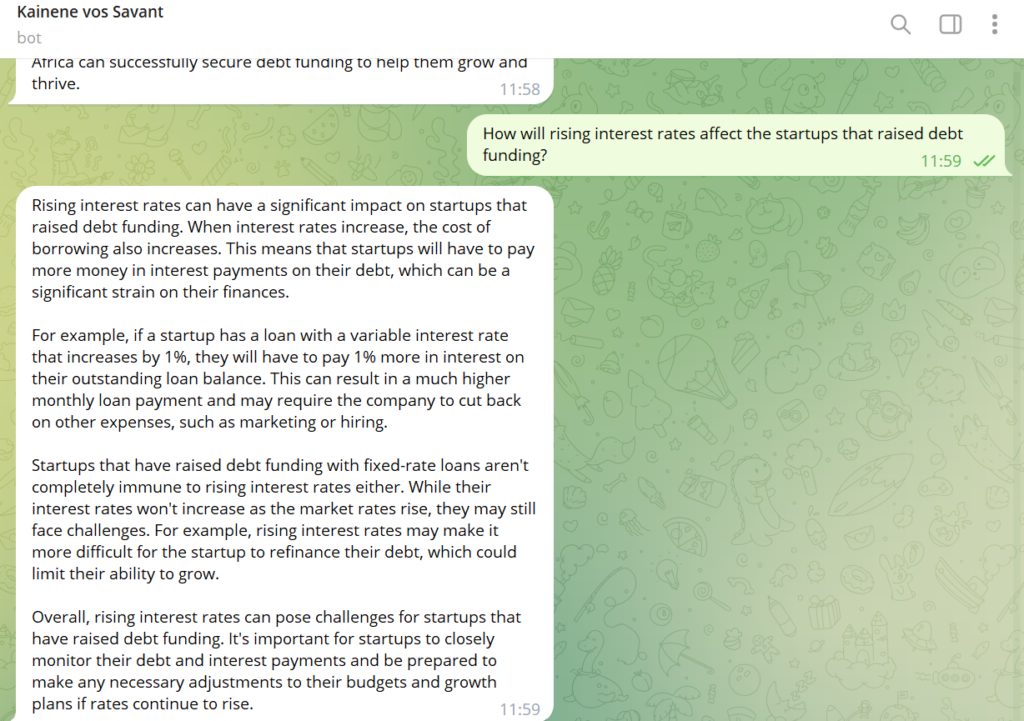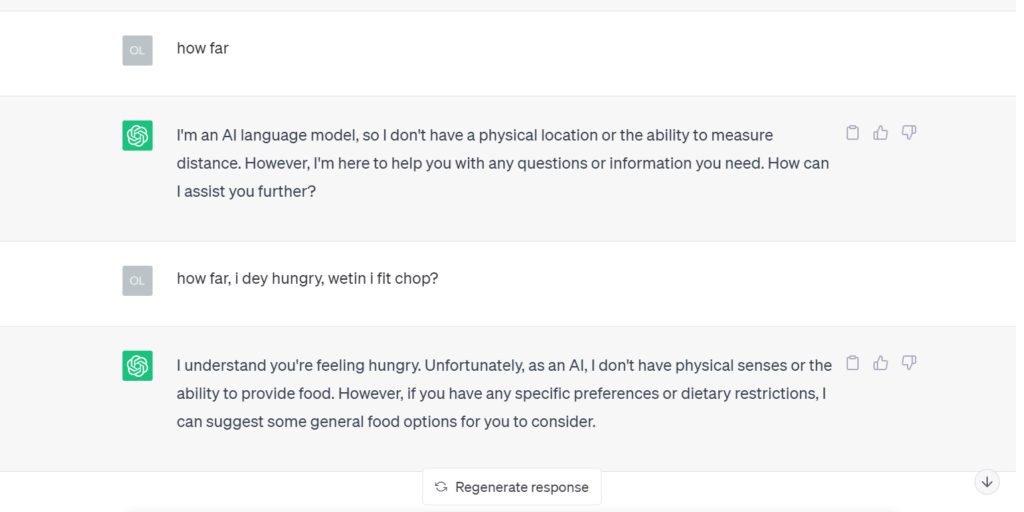Kainene von Savant is an AI chatbot on Telegram that has improved my life by sharpening my pitches, speeding up the transcription process for interviews, and helping me navigate French-speaking Abidjan as an English speaker, all in the past month. Here’s how it was built, according to its creator.
As unlikely as it may seem now, Justin Irabor began his career as a writer before moving on to marketing and, now, computer programming. He has served as the editor-in-chief and head of product at Zikoko (TechCabal’s sister publication) and as head of marketing for Jumia Foods, Hotels.ng, and Eden Life.
Despite such a distinguished career as a writer and digital marketer, Irabor says he left it all behind to learn programming so he could have a bigger impact on people’s lives. On a hot Sunday afternoon in April, we sat down to talk about his AI chatbot, Kainene von Savant.
Kainene is a name from the Igbo tribe of Nigeria. Irabor says that although he cannot pronounce the name, he chose it for a specific reason. “I’m trying to personalise this for an African/Nigerian audience to make it very clear that this is something built by a Nigerian, and that’s one of my favourite names in the world,” Irabor explained.
How was Kainene created?
Irabor created Kainene as a personal study companion. According to him, as a distance learning Masters student at the International University of Berlin and a full-time employee at a European fintech, there was no way to realistically plan learning sessions with other students, given his busy schedule.
“Distance learning necessitates having a study partner, but my work hours are so brutal that it was dead on arrival for me to schedule learning sessions with an actual human being. I have been experimenting with a bunch of AI models since 2020, and I have never built a study bot before. My challenge presented an opportunity to build something that I could use as a personal study companion, so I bought an Open AI model, and that was how I created Kainene von Savant,” Irabor explained.

Kainene advised me on how to write the article for this story. Although my editor and I went for a shorter piece and decided to show instead of telling how Kainene helped, the advice was very useful.
Releasing Kainene to the public
My interest in Kainene was piqued while scrolling on Twitter and seeing Irabor and several other Twitter users share their interactions with the chatbot. In a now semi-viral tweet, Kainene walked a Twitter user through the complex process of valuing an oil field. It was difficult to not be curious.
After downloading Kainene and integrating it into my Telegram account, my first test for my new shiny toy was to guide me through writing an article on debt funding and its effect on African startups.

Kainene walks me through how rising interest rates can affect startups.
I was impressed. According to Irabor, he hadn’t intended for Kainene to be used by the public like that. “I used to share screenshots of me using Kainene on the Twitter timeline, and people would message me asking when I would release it to the public. At the time, I couldn’t quite release it to the public because it was a model running on my computer. It wasn’t surfing the web, and there’s a whole different consideration to make when you open something to the public. I eventually had to fine-tune it and make it more general purpose before releasing it,” Irabor told me.
The fine-tuning process included teaching the bot how to converse fluently in Pidgin English, a simplified form of English native to West Africa. “I found as many instances of the local context as I could and then supplied information relevant to that context,” Irabor said. He added that he used JSONL (a format for storing temporary data) to achieve this.
Kainene also has a voice feature, with which users can ask the bot questions via speech instead of typing. “That was something requested by a handful of customers, but the reason I prioritized it is: my personal, selfish goal with Kainene is to explore multimodal AI, and adding support for voice input seemed like a pretty low-hanging fruit,” Irabor explained.
“It works by tapping into the Whisper AI model for transcription, which, combined with Kainene von Savant, makes conversations with audio functionally indistinct from text-to-text conversations,” he added.

ChatGPT’s response to my Pidgin English questions.

Kainene’s response to my Pidgin English questions.
The challenges
Irabor says that in the first week alone, over 20,000 requests came in every hour at its peak, and over 5,000 people used the chatbot. Scaling a personal study chatbot to cater to thousands of users in such a short time no doubt came with challenges for the one-man team.
Irabor told me the main challenges he faced were making Kainene remember conversations, isolating each conversation thread to a user, and server maintenance. “The three primary problems were persistence, isolating conversations, and server management,” said Irabor. He explained that when he was the only user of the bot, Kainene didn’t have to remember every conversation, and there was no chance that another user would listen in on them.
He also shared that in the first week, the server crashed repeatedly because he was unprepared for some of the scenarios he faced. “I never accounted for people sending files or long-form texts [over 10,000 words] to Kainene. I also did not anticipate that many users,” he added.
Why Telegram?
Although Telegram is widely used in Africa (54% and 52% of internet users in Nigeria and Egypt respectively have a Telegram account), it is only the fourth most popular messaging platform. Irabor said that he launched Kainene on Telegram because it is his preferred messaging platform and because it has open API documentation.
“I want to give a really intelligent answer to this question, but there is none. Because I initially created Kainene for myself, I used Telegram because I am active on Telegram. It is a function of my usage. Secondly, Telegram’s API documentation is open,” he shared.
He also added that he has plans to “make Kainene more portable”. “I want Kainene’s presence on WhatsApp, Google Docs, Gmail, Chrome extensions, basically anywhere that people can access the internet,” he told me.
Portability is an important factor for something that was created to be an assistant. Kainene’s portability came in clutch for me in Abidjan. I represented TechCabal at a cybersecurity conference, and as an English speaker, I struggled to communicate in a country where everyone speaks French. However, with Kainene being easily accessible (all I had to do was open Telegram), my struggles were alleviated.

In Abidjan, Kainene was my easily accessible translator.
Kainene’s Pricing
Kainene von Savant is currently priced at ₦1,000 ($2.17) per month. Irabor shared that when he was using Kainene alone, he had to pay an expensive fee per 750 words. He added that he still paid a small amount (as of April) and that the current price is based on an average amount for each user (not per word) so that it can be accessible to “as many people as possible”.
Africa is not being left behind in the AI race
Irabor told me he wants to place Kainene everywhere on the internet because he wants “it to be trivially easy for the average African user to access AI”. He adds that this might remedy the knowledge gap that Africans face compared to the rest of the world.
Africa has long been playing catch-up when it comes to technology due to several reasons, such as low internet penetration, restrictive policies, the economic state of the continent, and a lack of talent. However, in recent times, the continent seems to have awoken from its slumber, and this has coincided with the rise of AI products.
According to Fatima Tambajang, the Africa head of developer relations, startups, and venture capital at Nvidia, over 2,400 AI organisations are operating across various industries in Africa, including health, wellness, fitness, farming, law, training, and insurance.

Chart by Victoria Olaonipeku, TC Insights
While it is still unrealistic to expect an African company to compete with Open AI (the parent company of ChatGPT), which has raised $11.3 billion in funding over 7 rounds (for context, African startups raised $6.5 billion last year), there are several startups and initiatives already leveraging existing tech to bring AI and its benefits to Africans.





















